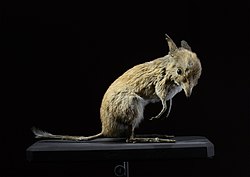| Northern pig-footed bandicoot | |
|---|---|
 | |
| Scientific classification | |
| Kingdom: | Animalia |
| Phylum: | Chordata |
| Class: | Mammalia |
| Infraclass: | Marsupialia |
| Order: | Peramelemorphia |
| Family: | † Chaeropodidae |
| Genus: | † Chaeropus |
| Species: | †C. yirratji |
| Binomial name | |
| †Chaeropus yirratji Travouillon et al. 2019 | |
The northern pig-footed bandicoot (Chaeropus yirratji) was a small species of extinct herbivorous Australian marsupial in the genus Chaeropus , the pig-footed bandicoots. It has been believed to be extinct since the mid-20th century; the last confirmed observation was a specimen collected near Alice Springs in 1901, but reports from local Aborigines indicate that it may have survived in the Gibson and Great Sandy Deserts as late as the 1950s. [2] [3] [4]
It very closely resembled and was formerly considered conspecific with the related southern pig-footed bandicoot, but unlike C. ecaudatus, C. yirratji was restricted to grassland habitats in the deserts of central and western Australia. It also had a longer tail and hind feet, a different dentition, fewer holes on its palate, and a distinct coat coloration. It had at least two different color morphs; a light morph and a dark morph. This species likely went extinct due to the introduction of invasive red foxes and feral cats, as well as habitat degradation for livestock. [2] [4] [5]
